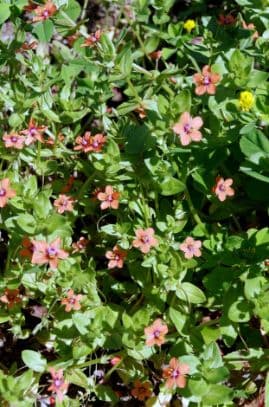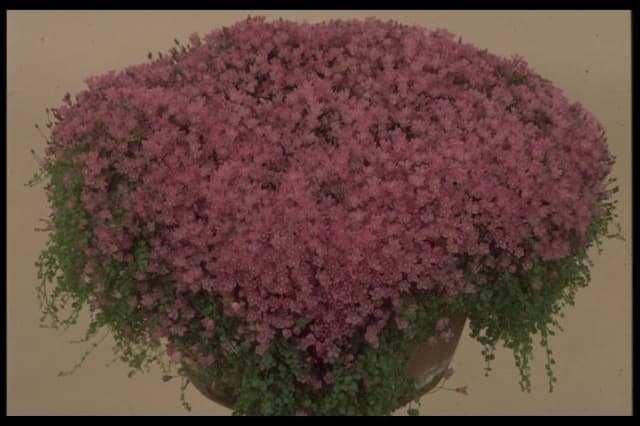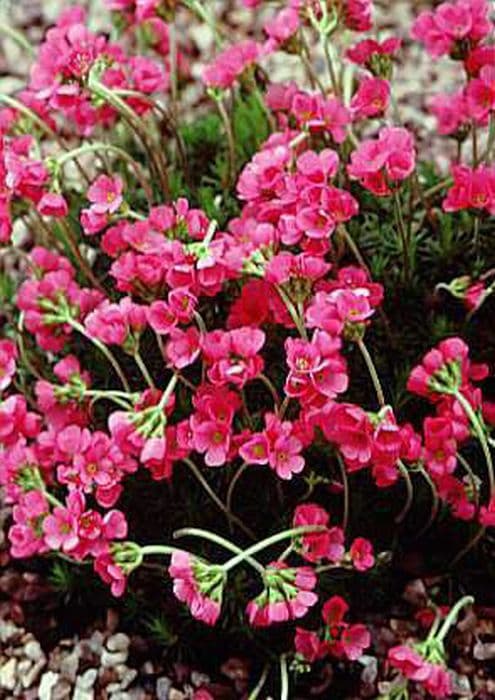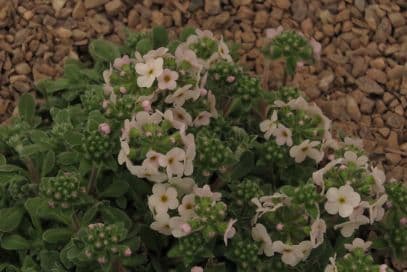Bear's ear Primula auricula L. (Au)

ABOUT
The Primula auricula, commonly known as the auricula or mountain cowslip, is a charming flowering plant admired for its vivid blossoms and distinctive foliage. The plant showcases a rosette of smooth, fleshy leaves that are somewhat rounded with a hint of a point at the tip, providing a lush green backdrop for its flowers. The foliage might exhibit a powdery coating, giving it a unique texture. The blooms of the auricula are its most striking feature, presenting themselves in a dazzling array of colors that can range from deep purples and blues to bright yellows, reds, and pinks. These intensely colored flowers are often marked with contrasting vibrant patterns or a white or yellow center, known as the eye, adding to their visual appeal. Each individual flower is shaped like a small trumpet, contributing to an overall ornate effect when clustered together in tiered patterns at the top of the stalk. The auricula's beauty is further enhanced during its blooming period when the plant becomes a focal point of gardens and displays. Its richly colored flowers tend to be densely packed into umbrella-shaped clusters, making each flowering silhouette a delightful spectacle. Renowned for its ornamental value, the auricula is a beloved plant among garden enthusiasts, often featured in alpine gardens, rockeries, and as a captivating addition to potted arrangements. Its striking appearance and the variety of available colors make the auricula a prized possession for those who appreciate the vibrant showiness and quaint charm of this lovely plant.
About this plant
 Names
NamesFamily
Primulaceae.
Synonyms
Bear's Ear, Mountain Cowslip, Auricula, Bear's-Ear Primrose.
Common names
Primula auricula var. ciliata, Primula auricula var. dentata, Primula auricula var. lanata, Primula lutea var. auricula, Primula auricula subsp. ciliata, Auricula vulgaris, Primula auricula subsp. serratifolia, Primula officinalis Hill.
 Toxicity
ToxicityTo humans
Bear's ear is generally not considered toxic to humans. However, like with many plants, some individuals might be sensitive or allergic to it, possibly causing mild irritation upon contact with the skin or when ingested. Ingestion is typically not associated with serious poisoning or severe symptoms in humans.
To pets
Bear's ear is not typically toxic to pets. While it might cause mild stomach upset if ingested in large quantities due to the presence of saponins, it does not usually lead to severe poisoning or life-threatening symptoms. Care should be taken to prevent pets from eating large amounts of any non-food plant, as individual reactions can vary.
 Characteristics
CharacteristicsLife cycle
Perennials
Foliage type
Evergreen
Color of leaves
Green
Flower color
Varies
Height
0.5 feet (15 cm)
Spread
0.5 feet (15 cm)
Plant type
Herb
Hardiness zones
4
Native area
Europe
Benefits
 General Benefits
General Benefits- Ornamental Value: Primula auricula, commonly known as Auricula, is valued for its bright, unique flowers that add aesthetic appeal to gardens and landscapes.
- Easy Maintenance: Auriculas are known for being easy to care for, making them suitable for gardeners of all skill levels.
- Long Blooming Season: They have a relatively long flowering period, which ensures a colorful display for an extended time in the spring and early summer.
- Attracts Pollinators: The vibrant flowers of the Auricula can attract beneficial insects such as bees and butterflies, aiding in the pollination of nearby plants.
- Compact Size: Due to their small and compact growth habit, they are well-suited for rock gardens, borders, and container planting.
- Variety of Colors: Auriculas come in a wide range of colors and patterns, providing options for various garden design themes.
- Cold Tolerance: These plants are hardy in cool climates and can withstand cold temperatures, making them a good choice for mountain and northern gardens.
- Propagating Ease: Auriculas can be easily propagated through offsets, which allows gardeners to expand their collection or share with others.
 Medical Properties
Medical Properties- Anti-inflammatory: Primula auricula has compounds that may help reduce inflammation in the body.
- Diuretic: Traditionally, the plant has been used to promote the production of urine and relieve fluid retention.
- Expectorant: Compounds in Auricula can potentially aid in clearing phlegm from the respiratory tract.
- Anxiolytic: There is some evidence that certain species in the Primula genus may have stress-relieving effects.
 Air-purifying Qualities
Air-purifying QualitiesThis plant is not specifically known for air purifying qualities.
 Other Uses
Other Uses- Auriculas are often used in Alpine rock gardens for their colorful and unique blooms that enhance the aesthetic appeal of such environments.
- In folk art, the auricula has been used as a motif in paintings and embroidery, symbolizing its status in horticultural societies.
- These plants can be used as a natural dye source; their petals impart varying shades of yellow to fabrics and yarns.
- Auriculas serve an educational purpose in botanical studies due to the diverse range of colors and forms they exhibit, which demonstrate plant genetics and hybridization.
- The flowers are sometimes crystallized and used as edible decorations for cakes and desserts.
- In theater, auriculas have been used as a symbol in plays and literature to represent rarity and the ephemeral nature of beauty.
- Auricula petals can be used in potpourri mixtures, contributing their subtle fragrance to the mixture.
- The unique shape and structure of the auricula flower make it an ideal subject for botanical illustration classes and workshops.
- Photographers and artists may use auriculas as a subject to study color contrast and composition due to their distinctive palette.
- Gardeners sometimes plant auriculas in containers within courtyard gardens to create an old-world charm ambiance.
Interesting Facts
 Feng Shui
Feng ShuiThe Bear's Ear is not used in Feng Shui practice.
 Zodiac Sign Compitability
Zodiac Sign CompitabilityThe Bear's Ear is not used in astrology practice.
 Plant Symbolism
Plant Symbolism- Uniqueness: The Auricula (Primula auricula) is known for its unique and varied colors, symbolizing the beauty of being different and embracing individuality.
- Boldness: With its bright and bold colors, the Auricula represents courage and the willingness to stand out from the crowd.
- Elegance: The sophisticated shape and arrangement of the flowers convey a sense of grace and refinement.
- Theatricality: Often grown and displayed by enthusiasts in Auricula Theatres, the plant is associated with a sense of drama and performance.
 Water
WaterBear's ear auricula should be watered to keep the soil moist but not waterlogged; typically, this means watering about once a week with about 8-16 ounces of water, depending on the size of the pot and the environmental conditions. During the growing season in spring and summer, the frequency of watering may increase, especially if the weather is warm and dry. In the winter, reduce watering to prevent root rot, but do not let the soil dry out completely. It is best to water at the soil level to avoid wetting the foliage, which can lead to fungal diseases.
 Light
LightBear's ear auricula thrives in bright, indirect sunlight or partial shade. Avoid placing it in full sun, especially during the hot afternoon hours, as this can scorch the leaves and lead to stress for the plant. A north or east-facing windowsill or a shaded patio is an ideal spot for the Bear's ear auricula, where it can receive plenty of light without being exposed to the harsh direct rays of the sun.
 Temperature
TemperatureBear's ear auricula prefers cooler temperatures and is hardy in a range between 40°F to 75°F. It can survive short periods of lower temperatures down to about 20°F but should be protected from extended exposure to freezing conditions. The ideal growing temperature for Bear's ear auricula is between 50°F and 70°F, keeping it away from extreme heat or cold drafts.
 Pruning
PruningPruning of Bear's ear auricula is primarily for removing dead or yellowing leaves and spent flowers to encourage new growth and maintain a tidy appearance. Prune after flowering in the spring or early summer, using clean shears to avoid spreading disease. Deadheading the flowers once they've faded will often prompt a second bloom.
 Cleaning
CleaningAs needed
 Soil
SoilBear's Ear requires a well-draining soil mix with a pH range of 6.0-7.5. A blend of loam, peat, and perlite or gravel works best to provide adequate drainage and aeration. Regular feeding with a balanced fertilizer will support healthy growth.
 Repotting
RepottingBear's Ear should be repotted every 1-2 years to refresh the soil and encourage growth. It's best done after flowering in late spring or early summer, using a slightly larger pot to accommodate root expansion.
 Humidity & Misting
Humidity & MistingBear's Ear thrives in moderate to high humidity levels but is adaptable to average household humidity. Aim for a relative humidity around 50-60% for optimal growth without extra measures.
 Suitable locations
Suitable locationsIndoor
Keep Bear's Ear in bright, indirect light, and maintain moist soil.
Outdoor
Plant Bear's Ear in partial shade, protect from harsh sun.
Hardiness zone
4-8 USDA
 Life cycle
Life cycleThe Primula auricula, commonly referred to as Auricula Primrose, begins its life cycle from seeds which germinate in cool, moist conditions. Upon germination, seedlings develop into a rosette of thick, sometimes farinose (mealy) leaves. The vegetative phase is followed by the flowering stage, typically in spring, when the plant produces bright, often multicolored flowers arranged in umbels atop long stalks. After pollination, often by insects, the flowers develop into capsule fruits filled with tiny seeds. The plant then goes into a period of dormancy during the summer, where it may appear to die back as it conserves energy for the next growing season. In its perennial nature, the Auricula Primrose resumes growth from the rootstock, repeating the cycle for several years.
 Propogation
PropogationPropogation time
Spring-Early Summer
The most popular method of propagation for Primula auricula, commonly known as Auricula or Bear's Ear, is by division. This is typically done in late summer after the plant has finished flowering. The clump should be carefully lifted from the ground, and using a sharp, clean knife or spade, the clump is divided into smaller sections. Each section must have at least one shoot and a portion of the root system. These divisions can then be replanted immediately in well-draining soil at the same depth they were previously growing. Water the new plants thoroughly after planting to help establish them. This method allows for a quick increase in the number of plants and is an easy way for gardeners to propagate Auriculas.









